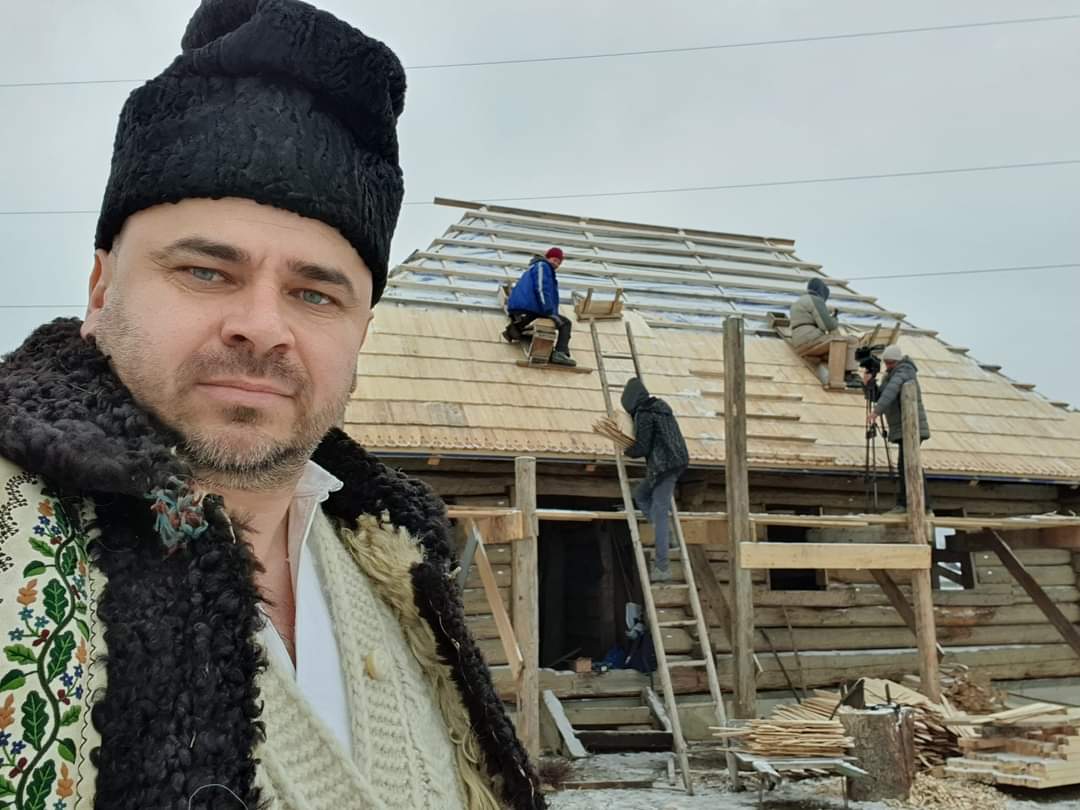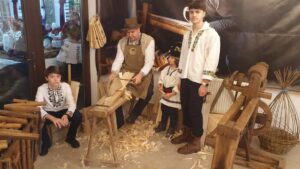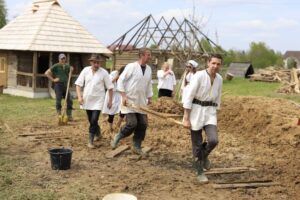
Iosif Cistean leading the installation of a wooden roof.
1. Please introduce yourself (profession, area of expertise and years of experience).
My name is Iosif Cistean. I’m 44 years old and I’m a carpenter by profession, graduated from the professional school. I have been working in this profession for approximately 18 years.
2. What clients/markets do you work with (are they local, national or international)? Which needs does your work generally tackle? Which are the required skills and certifications that your customers request?
I work mainly with national clients in Romania, most of whom are individuals and a small part of which are companies. We essentially supply them with the wooden shingles that are used to cover traditional wooden roofs of houses and other structures during restoration and enhancement projects.
3. Please briefly explain how your profession is related to religious heritage and/or cultural heritage.
This profession is closely linked to cultural heritage, as it is about maintaining traditions, especially in terms of know-how. But there is also a relationship with the religious heritage because the people who made such buildings were very religious. Unlike what happens with today’s houses, people had a direct link with the material. What we want to transmit by promoting traditional wooden constructions is precisely the fact of being able to pass on something meaningful to others.
4. Please describe the main steps of your usual working process and the materials that you use most.
The first step is to choose the material directly from the forest. Specialists have secrets and tricks for finding the right wood for the right place. We can’t use just any wood. Once the wood has been chosen, it is cut and brought to the workshop in pieces of 60 centimetres, which is the standard length of the shingles. These pieces are the material we will be working with.
It’s important that we treat and transform the wood in different stages. First, we cut each piece thinner and thinner until they are 8mm thick. Then, on each side, we apply a special coating that will flatten the surface of the shingle and we press it with a special press. Finally, we let the wood dry naturally.
After this process, there are two possibilities: either these bars are sent to a specialist to be treated, or they are used in an untreated form, in their natural form. If we choose an untreated form, the shingles would be ready to be nailed onto the roofs.

5. Do you regularly cooperate with craft professionals from other fields? If yes, can you explain which ones and why?
When it comes to roofing with wooden shingles, there is a need for additional insulation which allows the shingles to be preserved. We are always looking for innovative materials that can provide this insulation without affecting the performance of the shingles over time. So yes, it is necessary to collaborate with other specialists.
6. Please mention any innovation that helped improve your work (technological, digital, material related, legal…) and explain the impact they had on your profession
There is very little innovation in our field, due to the fact that we work in a traditional way and all steps have to be done manually. Of course, our way of working has changed compared to previous generations, as we now use chainsaws to cut the wood when we collect it from the forest. But all the other steps are still done by hand. This allows us to maintain the quality of the wood and the final product.
The only area where there has been innovation (and I have no doubt over time will evolve towards better quality) is the treatment of shingles. We now use a system that consists of putting the shingles on some sort of “wine” to preserve it. This product penetrates into the wood fibre, preserving it better than it used to in the past.
7. How did you learn the profession? Can you detail your learning path mentioning schools and workshops where you were trained?
The basis of my knowledge in woodworking comes from professional school. I took a two years long course. In the first year, we learned mostly manual work. In the second year, we learned about mechanisation systems in construction.
On the other hand, I learned about cladding from a person in the village who had himself learned the trade from his grandfather. I have no direct family link with this craftsman. The trade has been passed on from generation to generation in the village, and now he is the last person who still knows the traditional manufacturing techniques of wooden shingles.
8. Do you pass on your knowledge to young people? If yes, how? In schools, through workshops…?
Yes, we have a shingle-making workshop in an old barn that should normally have been demolished. We took it over and set up a series of workshops and activities on the site. So the first way of transmission of this craft happens here, in this workshop which remains in operation all week long. We are many shingle artisans in the same space and we promote our work regularly through Facebook and social media, so we regularly receive groups of young students from the professional school who come to see the workshop.
The second way we pass on our expertise is through the city’s professional school. We work with teachers and some students who come to do an internship and gain experience with us. There are many buildings that need restoration in different places, so the school offers internship and volunteering opportunities to young people to learn and at the same time work directly on the restoration of the building.

9. What would you recommend to a young person interested in your profession? What are the opportunities and areas in which they can work with your skills?
The first thing to bear in mind is the fact that this is a business for people that work with traditional tools and methods. It’s really a very pleasant working environment and one doesn’t need to use a mask as we work with natural products.
Another advantage is that you can work at home, you have your own workshop in the courtyard of your house, which of course means you can stay close to your family, and have your own garden and animals, which is important in these rural areas of Romania.
It is important that the person who wants to work in this field is close to simple things and not necessarily attracted by big modern houses and a nice car, because this is not a field in which you’re going to make the most money, but on the other hand there are many positive aspects.
This profession may not attract hundreds of young people, but what is important, is to guarantee that those who are interested can find the places and the people that are able to transmit the knowledge.
I would like to point out that since the post-revolution era, many Western countries have brought in products from abroad, replacing ancestral methods of crafts. So in the last few decades, traditional methods have been forgotten. However, now that we are more globalised, there seems to be an interest in recovering craftsmanship, traditional know-how and traditional building systems
10. What are the threats that may endanger your profession? Can you mention some difficulties that are associated with your work? Which could be the solutions to better support your profession and preserve the transmission of skills?
The main danger of this profession, and in particular the demand for shingles, is that there are very few workshops within a 5 km radius. This means that there is no competition and few shingles are produced this way, so the price is quite high and it is difficult for people with lower incomes to be able to roof with them.
There are several solutions. The first is to make it more attractive for young people while always remembering that it has to be a passion. Another quite important fact is to guarantee financial support from local authorities and perhaps even at the national level by legislation. This would allow supporting the craftsmen with the production and make it more affordable for individuals and interested companies to preserve traditional roofs.
So in a few words, we need passionate people and financial support.
You can find out more about Iosif Cistean’s work on Facebook: Ambulanța căsuțelor bucovinene and Dranita de Bucovina
 Mad’in Europe (MIE) is a small company committed to promoting craft professionals and crafts professions and to supporting the transmission of crafts skills at a European level. Its multilingual portal gathers a large audience around the profiles of 1,500 crafts, restorers and fine crafts professionals. As a member of some European organizations and thanks to its wide European network MIE participates in several transversal activities including Erasmus and Horizon projects which focus on valorisation of crafts, preservation of traditional know-how, and raising awareness among young people, for whom the sector represents a source of employment.
Mad’in Europe (MIE) is a small company committed to promoting craft professionals and crafts professions and to supporting the transmission of crafts skills at a European level. Its multilingual portal gathers a large audience around the profiles of 1,500 crafts, restorers and fine crafts professionals. As a member of some European organizations and thanks to its wide European network MIE participates in several transversal activities including Erasmus and Horizon projects which focus on valorisation of crafts, preservation of traditional know-how, and raising awareness among young people, for whom the sector represents a source of employment.
 Future for Religious Heritage (FRH) is an independent, non-faith, non-profit European network founded in 2011 and based in Brussels to promote, encourage and support the safeguard, maintenance, conservation, restoration, accessibility and embellishment of historic places of worship. Our network represents more than 80 organisations and over 120 professionals from 36 countries, which includes NGOs, governmental organisations, religious and university departments, and individuals. We are one of the 36 European networks currently supported by the Creative Europe Networks programme.
Future for Religious Heritage (FRH) is an independent, non-faith, non-profit European network founded in 2011 and based in Brussels to promote, encourage and support the safeguard, maintenance, conservation, restoration, accessibility and embellishment of historic places of worship. Our network represents more than 80 organisations and over 120 professionals from 36 countries, which includes NGOs, governmental organisations, religious and university departments, and individuals. We are one of the 36 European networks currently supported by the Creative Europe Networks programme.





Follow us: